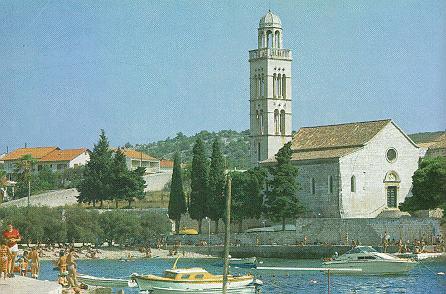

The monastery is situated on the tongue of land beside the bay called Kriza to the south of the town. It was built between 1461 and 1471 as a retreat for sailors. The cloister, with its monumental rounded arches with a well in the middle, dominates the whole of the Renaissance monastery. The whole complex is surrounded by lush gardens and is walled.
The former spacious refectory and a small, adjacent room have been turned into the monastery museum. Along with a collection of old books and coins, the famous "Last Supper", a work belonging to the Venetian School of Palma the Younger from the end of the 16th century, has the strongest claims on the attention of the numerous visitors.
There is a 300 year old cypress tree of impressive size and of magnificent shape in the garden in front of the dinning-room. From the garden there is a superb view of Hvar harbour and the Paklinski islands, which is unforgettable, especially at dusk.
The monastery church of Our Lady of Mercy was built on the site of the former small chapel of the Holy Cross in 1475.
The bell tower, of a fine Renaissance style, is the work of an artist from Korcula. It is one of the four church towers in Hvar which are considered to be the most beautiful in Dalmatia.
There is a Renaissance portal on the facade of the church which has a fine relief of "Madonna and Child" in the tympanum dating from the middle of the 15th century. It is from the workshop of the Renaissance sculptor Nikola Firentinac.
The interior of the church has two sides. The nave is divided into two by the wooden reredos and the choir. There is a polyptych on the high altar by the Venetian artist Francesco de Santacroce (1516-1584). In front of the altar is the tomb of the poet Hanibal Lucic, the author of the first Croatian secular drama "Robinja" ("The Slave-Girl"). The wooden choir stalls are among the oldest in Dalmatia. They were made by the artist Franjo Ciocic of Korcula and Antun Spija of Zadar in 1583.
On the upper part of the reredos there is a cycle of six scenes from "Christ's Passion" by Martin Benetovic (1607), a writer of comedies and an organist, and the author of "Hvarkinja" ("The Woman of Hvar" and "The comedy of Rastoc"). On the lower part of the reredos Francesco de Santacroce painted the cycle of paintings from Mary's life. On the south wall of the nave there is a painting directly opposite in the side aisle. The chapel of the Holy Cross has a Gothic vault and is divided from the aisle by a late Gothic stone screen, a work by Petar Andrijic. There is a colourful and resplendent painting of "The Crucifixion" by Leonardo Bassano (1560-1623) on the altar, which is one of the most valuable paintings of the Hvar collection.
The nave of the church, above the reredos, is dominated by a huge wooden crucifix.
The monastery was damaged by the Turks (the attack of Uluz Ali) in 1571, but was soon repaired in 1574.
The wall round the monastery dates from 1545, and the series of little baroque chapels that stretch from the monastery to the town, were built by the commander of the Adriatic fleet Marin Capello in 1720.
At the end of the series of little chapels a street of characteristic paving
stones goes through the outlying district to the main square. This is a
picturesque street intersected by a series of smaller transversal streets,
usually in the form of a flight of steps, edged by stone buildings ranging
in style from Gothic to Baroque.